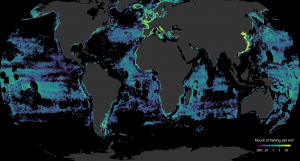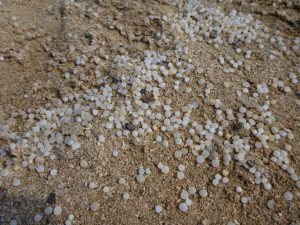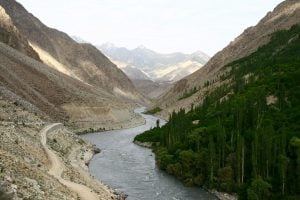It looks like green snow, piled up in drifts along the shore of the Yellow Sea. Mountains of algae have become a stark image of marine pollution off the coast of China. In Qingdao, a major city in Shandong province, one of the cities often worst affected, the authorities employ bulldozers to remove thousands of tonnes of the invading algae from beaches.
The giant algal “blooms” are an annual phenomenon offshore, though they do not always reach beaches. The largest in the Yellow Sea so far have occurred in 2013 and 2017, when they covered almost 30,000 square kilometres of coastal waters (a quarter of the size of North Korea).
Dead zones
China has a problem with algae in the ocean. While alive, the algae can become a tourist attraction. Mostly they are non-toxic. But when the tiny marine plants die after a few days, their decomposition consumes the ocean’s oxygen and creates stinking dead zones, where little can live.
Dead zones can occur naturally. But off the shores of China, they are largely a result of excess nutrients, mainly nitrogen. The nitrogen comes from several sources. There is fallout into the ocean from nitrogen oxides emitted into the air from power stations and vehicle exhausts. And there is what comes down the country’s great rivers. This includes untreated human sewage; manure from the country’s fast-growing livestock farms; and especially excess fertiliser put onto fields by farmers.
In China’s national effort to feed more than 1.3 billion people, its farmers pour more fertiliser onto every hectare of land than farmers anywhere else – more than 200 kilograms. That is twice as much as their European compatriots, for instance, and more than 50 times the application rates in China in the early 1960s.
More than two decades ago, the American environmentalist Lester Brown wrote an apocalyptic book asking “Who Will Feed China?”. The answer turned out to be the Chinese. But it took a lot of fertiliser. About 30% of current global fertiliser use is in China. And an increasing amount of that fertiliser never reaches crops but washes into drains, rivers and the ocean.
The problem for farmers is that there is a law of diminishing returns. For every extra kilogram of fertiliser added to fields already almost saturated with the stuff, less and less reaches the crops and more and more washes off into rivers. If the fertiliser is cheap enough, then the farmer still wins. But the environment increasingly loses.

Nutrient overdose
The standard measure is nitrogen use efficiency – an index of how much of the nitrogen makes it into plants. A recent study by Xin Zhang of the University of Maryland estimated China’s nitrogen use efficiency at just 25%, the lowest in the world. The global average is 42% and the United States achieves 68%.
Moreover, China’s nitrogen use efficiency has been declining for half a century as the country has tried to boost farm yields. Zhang estimates that in 1961 China’s nitrogen use on fields was more than twice today’s efficiency, at around 60%.
China is not alone. Most developing nations see a decline in nitrogen use efficiency as they seek to boost output yields. India’s efficiency index has slipped in the past two decades from 40% to 30%. Sub-Saharan Africa’s efficiency remains high because the continent uses less fertiliser. But that is unlikely to last.
One reason China’s decline has been greater than many other nations is because its nitrogen applications are greater, which is in turn a result of deliberate policies to heavily subsidise fertiliser production.
Another is China’s mix of crops. China has seen a huge increase in production of fruit and vegetables since the 1980s. These crops generally have an intrinsically low efficiency in their use of nitrogen. They now account for 30% of China’s nitrogen applications to fields. China on the other hand imports a lot of soy as feed for livestock, particularly from Brazil. Soy uses nitrogen very efficiently.
Killer weed
The effects of the heavy nitrogen run-off from Chinese rivers are severe. Algal blooms are reported from a third of its freshwater lakes, including the five largest, and nitrogen is killing fish in rivers from Shandong to the Pearl River. And then there is the ocean.

Beside the algal blooms of the Yellow Sea, another recurring Chinese ocean dead zone is off the Changjiang (Yangtze) estuary in the East China Sea. In 2013, the oxygen loss was estimated at more than five million tonnes. Scientists have linked it to the loss of fish in the East China Sea, and the failure of bans on trawling to allow fish stocks to recover.
Beside the flows of nitrogen down Chinese rivers, some people have also blamed these dead zones on seaweed aquaculture. There are huge areas of porphyra farms in coastal waters along the East China Sea coastline. They account for two-thirds of global production. The concern is that in spring when farmers clear the seaweed, they throw it into the ocean, where its rotting consumes oxygen.
But there is another story. For, while alive and growing, the seaweed helps to absorb excess nutrients in the water lapping round them. So, if the waste problem could be eliminated, seaweed could become part of the solution, says Xi Xiao of Zhejiang University.
She calculates that a 17-fold increase in the extent of the seaweed farms would be enough to absorb all the excess nitrogen currently entering Chinese waters.
Global problem
Excess nitrogen fertiliser in the ocean and other environments is rapidly becoming a global epidemic. Worldwide, some 120 million tonnes of synthetic nitrogen – fixed from the atmosphere by the Haber-Bosch process – is used on the world’s farms each year. That is twice the amount coming from natural sources such as animal manure, crop residues or nitrogen fixing plants.
More than half of the synthetic fertiliser ever applied to the world’s fields has been applied in the past 30 years. But of the 120 million tonnes applied to fields, only about 50 million tonnes reaches plants. The rest runs off into the wider environment and most eventually lands up in the ocean.
No wonder dead zones are a growing global phenomenon. More than 500 have been mapped from the East China Sea to the Baltic and the Black Sea to the Gulf of Mexico. Since 1950, their extent in coastal waters has increased tenfold.

Scientists analysing “planetary boundaries”, beyond which human activities are leading to potentially “irreversible and abrupt environmental change,” say nitrogen pollution is one of four that has already been crossed. (The others are deforestation, climate change and biodiversity loss.)
UN Environment (formerly UNEP) and the World Bank’s Global Environment Facility have launched a global strategy for reducing nitrogen waste and environmental pollution, known as the International Nitrogen Management System. It is set to report in late 2021. Among other things it is likely to call for more treatment of human sewage, more recycling of manure, reductions in food waste and a major assault of nitrogen efficiency on farms.
The last of these will involve a combination of breeding strains of major crops such as rice and wheat that use nitrogen more efficiently and replacing the current scattergun approach to dosing fields with fertiliser. Instead, the world needs more precision agriculture that delivers fertiliser at a time and place where the plants need sustenance. This involves both in-field monitoring of crops so farmers know exactly when and how much fertiliser to apply, and greater precision in placing that fertiliser close to crop roots.
Thankfully, historical precedent suggests that China may be at the low point of its nitrogen efficiency. Most industrialising countries eventually start to use fertiliser better and lose less. Both the US and Europe bottomed out around 1970. The US is now getting higher farm yields most years despite pouring less fertiliser, says Zhang.
Field trials suggest that fertiliser application rates for grain crops could be reduced by a quarter in China
Field trials suggest that application rates for grain crops could be reduced by a quarter in China without any impact on yields. But the turn-round may depend on government policy, such as reducing subsidies on chemical fertiliser that encourage farmers to pour more in the hope of slightly higher yields.
Beijing has recognised the urgency of the task. At the end of 2017, scientists calculated that a government target to halt further growth in the use of fertiliser on Chinese fields by 2020 – through more targeted use of more effective fertilisers – had been achieved three years early. Meanwhile efforts to curb emissions of nitrogen and phosphorus into vulnerable watersheds from large fixed sources were announced in April.
Zhang says that to get back within the planetary boundary for safe use of nitrogen will require improving global nitrogen use efficiency from 42%-70%. That, she suggests, might involve Europe and North America rising to 75%, and China getting back to the 60% efficiency levels it last achieved way back in the early 1960s.
The future of the China seas could depend on it.









